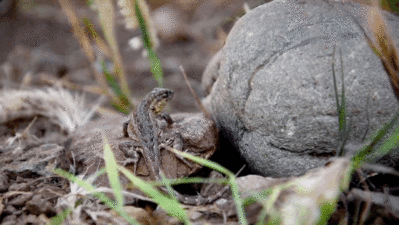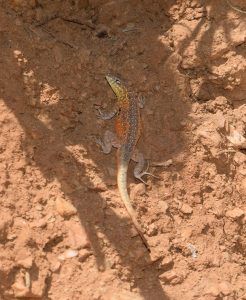
Walking down a dirt trail at CIMI, you may be startled by a sudden rustling in the foliage by your feet. Not to worry, it is usually the harmless, albeit timid, side-blotched lizard! These small members of the class Reptilia are seen throughout Catalina Island, hiding in rocks, hillside crevices, roots and shrubs. Because they are ectothermic, meaning they regulate their body temperature through external sources, you can often find them sunning themselves on top of warm rocks. Side-blotched lizards eat a wide variety of insects, and are abundant in the deserts of western North America.
The side-blotched lizard is one of the last lizards to enter hibernation in the fall, and one of the first to emerge in the spring. When the weather cools and does not provide enough heat for the lizard to maintain enough body heat for activity, they enter hibernation. This allows the lizard to survive months without the scarce food and water, surviving off the water and nutrients already in their bodies.
Side-blotched lizards exhibit polymorphism, which means they exhibit more than the normal number of morphs or “genders”. They actually have the highest number of morphs per species! There are three morphs for males, and two for females. One of the female morphs, the orange-throated females produce a lot of small eggs. Yellow-throated females produce a small amount of large eggs.
The males compete in a rock-paper-scissors way, where one male wins over another, but loses to a third. Orange-throated males are the most dominant, making them the rock. Blue-throated males are less dominant, making them the scissors. Yellow-throated males are the least dominant, making them the paper. However, like paper covering rock, yellow-throated males are sneakers and can cleverly steal females from the orange-throated males. Males will also guard their territories aggressively. If they see another male approaching their territory, they will perform pushups as a warning sign. If the intruder comes closer, the male will rush at them and begin butting and nipping.
 Lizards have a defense mechanism against predation called autotomy. Lizards are actually able to drop their tails when threatened! Because of a fracture plane in its spine, they are able to break their tail off and leave it to distract the predator. Sometimes the tail has bright colors, or eye-catching patterns, or can keep moving while the lizard stays still in the hopes that the predator will go after the tail instead of the rest of the lizard. This is often a last resort technique, because lizards often have fat deposits in their tails for hibernation or food shortage, and dropping the tail means losing that. It is also a lengthy healing process, and can take anywhere from a few months to a year to regenerate the tail.
Lizards have a defense mechanism against predation called autotomy. Lizards are actually able to drop their tails when threatened! Because of a fracture plane in its spine, they are able to break their tail off and leave it to distract the predator. Sometimes the tail has bright colors, or eye-catching patterns, or can keep moving while the lizard stays still in the hopes that the predator will go after the tail instead of the rest of the lizard. This is often a last resort technique, because lizards often have fat deposits in their tails for hibernation or food shortage, and dropping the tail means losing that. It is also a lengthy healing process, and can take anywhere from a few months to a year to regenerate the tail.
So, now you know that an animal missing a body part might be able to beat you in a pushup contest!


